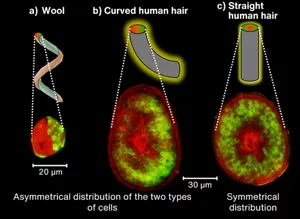Research on the Nature of Curved Hair and Bioinspired Technology for Controlling the Shape of Curved Hair
Hair Care
Curved hair is common problem. It is hard to manage and brings with it a lack of shine and moisturized feel. So Kao is examining the structural cause of curved hair and working to develop technology to control the shape of curved hair.
Focusing on tightly curled wool, we examined the structure of human curved hair jointly with the Wool Research Organization of New Zealand (now AgResearch Ltd.). It is known that wool contains two types of fibrous cells, namely ortho- and para-cortical cells, and they are asymmetrically distributed. Through our research, we found that human hair also has the similar two types of cells as wool, and they are distributed symmetrically in straight hair and asymmetrically in curved hair as in wool (Figure 1, where ortho-cortical cells are shown in red and para-cortical cells are shown in green).

Figure 1 Distribution of two types of fibrous cortical cells in different shapes of hair
Next, we considered how to control the shape of curved hair by taking advantage of this asymmetrical structure. When curved hair is immersed in water, it is relaxed slightly because of a small difference in swelling behavior between the two types of cells. When the hair dries, however, the curve returns. Then, we searched for substances that penetrate into hair and swell the tissue as water does, and developed a technology that effectively relaxes curved hair.
Kao is also focusing on the body hair of sea lions and seals, which live both in land and water. We, jointly with Asahiyama Zoo in addition to AgResearch Ltd, found that the body hair of these animals differs significantly in shape when in water and in air, and are working to shed light on the mechanism by which the shape of their body hair changes. We will continue to develop technologies that solve hair troubles, with the aim of helping people to get hair they desire.
- Home
- Innovation
- Research & Development
- Product Development Research
- Hair Care
- Research on the Nature of Curved Hair and Bioinspired Technology for Controlling the Shape of Curved Hair
- Home
- Innovation
- Research & Development
- Product Development Research
- Hair Care
- Research on the Nature of Curved Hair and Bioinspired Technology for Controlling the Shape of Curved Hair
